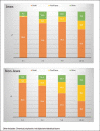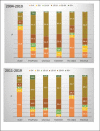Burns in Israel: Etiologic, Demographic, and Clinical trends-A 9-Year Updated Comprehensive Study, 2004-2010 versus 2011-2019
- PMID: 36172009
- PMCID: PMC9512588
- DOI: 10.1055/s-0042-1749094
Burns in Israel: Etiologic, Demographic, and Clinical trends-A 9-Year Updated Comprehensive Study, 2004-2010 versus 2011-2019
Abstract
Based on the Israeli National Trauma Registry (INTR) data, this study reports etiological, demographic, and clinical trends and includes all admissions to burn and trauma centers across Israel from 2011 to 2019 and compares these with 2004 to 2010 rates. From 2011 to 2019, 5,710 patients were admitted to burn centers across Israel. Children aged 0 to 1 years (25.9%), non-Jews (40.7%), and males (67.2%) remain the main groups of the burn casualties. Most of the casualties sustained 1 to 9% total body surface area (TBSA) burns with various depths. Scalds were less fatal than fire/flame-related casualties (<1 vs. 11.5%). Fewer surgical procedures were conducted for burns under 9% TBSA compared with greater TBSA. The percentage of TBSA and burn depth were found to be the most significant predictor of mortality among all age groups (>200 times increased risk with full-thickness burns >30% TBSA burn) and correlated with prolonged length of stay (>7 days).
Keywords: Israel; burns; etiology; risk groups; trauma registry.
Thieme. All rights reserved.
Conflict of interest statement
Conflict of Interest None declared.
Figures





References
-
- World Health Organization The global burden of disease 2004. update. Accessed March 3, 2022 at:https://www.google.com/url?sa=t&rct=j&q=&esrc=s&source=web&cd=&cad=rja&u...
-
- World Health Organization BurnsAccessed March 3, 2022 at:https://www.who.int/en/news-room/fact-sheets/detail/burns

